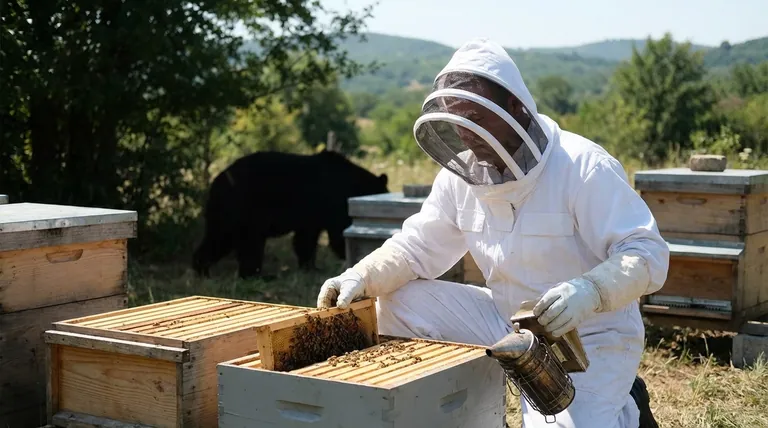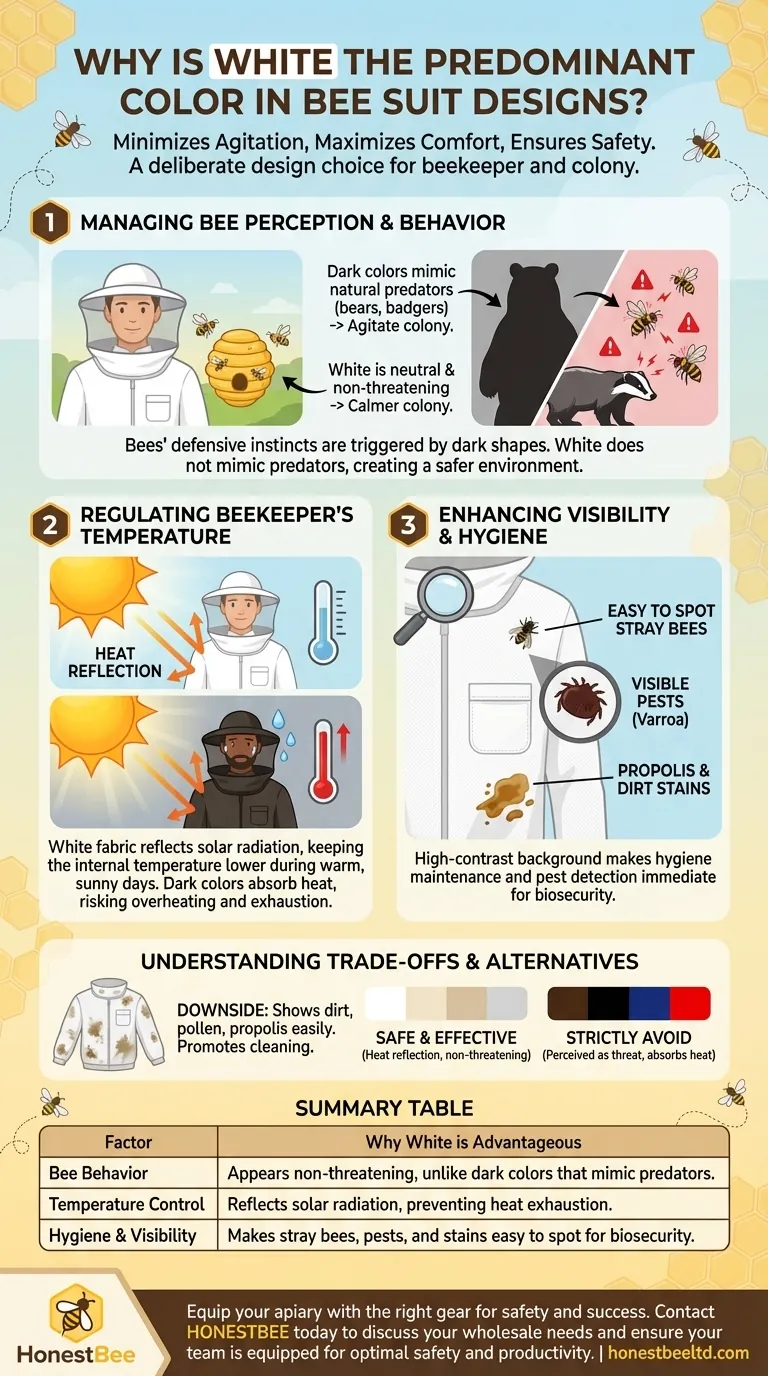The iconic white bee suit is a deliberate design choice, not simply a matter of tradition. Its prevalence is rooted in a deep understanding of bee behavior, the physics of heat, and the practical needs of the beekeeper. The color directly influences hive calmness, beekeeper comfort, and overall safety.
The decision to use white for beekeeping suits is a strategic one, designed to minimize two primary threats to a successful hive inspection: an agitated colony and an overheated beekeeper.

The Core Reasons for White
The standard white bee suit addresses three critical factors that every beekeeper must manage. Each reason is tied directly to creating a safer and more controlled environment for both the bees and the human interacting with them.
Reason 1: Managing Bee Perception and Behavior
Bees are hardwired for survival, and their defensive instincts are triggered by perceived threats. Dark colors are a significant trigger.
This is because the primary natural predators of honeybees—such as bears, badgers, and skunks—are typically dark and furry. When a large, dark shape approaches the hive, it can provoke a strong defensive response from the guard bees.
A white suit, in contrast, does not mimic these natural predators. It presents a neutral, non-threatening color that is less likely to cause alarm, allowing the beekeeper to work with a calmer colony.
Reason 2: Regulating Beekeepers' Temperature
Beekeeping is often performed on warm, sunny days when the bees are most active. Working in direct sunlight while wearing a full-body, protective suit creates a significant risk of overheating.
White fabric has a high level of heat reflection. It absorbs far less solar radiation than darker colors, keeping the internal temperature of the suit lower and the beekeeper more comfortable and focused.
This thermal regulation is not a minor convenience; it is a crucial safety feature that helps prevent heat exhaustion during long hive inspections.
Reason 3: Enhancing Visibility and Hygiene
A clean bee suit is essential for hive biosecurity, preventing the spread of pests and diseases. The white background of the suit serves a practical diagnostic purpose.
It provides a high-contrast canvas, making it easy to spot stray bees that may have crawled onto the suit. This is especially useful for ensuring the queen is not accidentally carried away from the hive.
Furthermore, dirt, propolis stains, or pests like Varroa mites are immediately visible on a white surface, signaling when the suit needs to be cleaned.
Understanding the Trade-offs and Alternatives
While white is the industry standard for sound reasons, it's worth understanding its limitations and why other colors are less common.
The Downside of White
The most obvious drawback of a white suit is that it shows dirt very easily. Propolis, pollen, and mud can quickly stain the fabric, making it look worn.
However, this high visibility of grime is also its strength. It forces the beekeeper to maintain better hygiene, which is critical for the health of the apiary.
What About Other Colors?
While less common, suits in other very light colors like tan, khaki, or light gray are sometimes used. These function similarly to white by being non-threatening to bees and reflecting a decent amount of heat.
Conversely, you should strictly avoid dark-colored clothing—including black, dark brown, dark blue, and even bright red (which appears black to bees). Wearing these colors near a hive significantly increases the risk of being perceived as a threat and provoking stings.
Making the Right Choice for Your Apiary
Your equipment choices should always prioritize the well-being of your bees and your own safety. The color of your suit is a foundational element of that philosophy.
- If your primary focus is safety and tradition: Stick with a classic white suit, as it is the proven standard for minimizing bee agitation.
- If you work in an extremely hot, sunny climate: White is non-negotiable for its superior ability to reflect sunlight and keep you cool.
- If you are considering an alternative: Choose only a very light color like tan or light gray, and always avoid any dark shade that could mimic a natural predator.
Ultimately, the color of your suit is a fundamental tool for communicating safety and calm to your bees.
Summary Table:
| Factor | Why White is Advantageous |
|---|---|
| Bee Behavior | Appears non-threatening, unlike dark colors that mimic natural predators (bears, skunks). |
| Temperature Control | Reflects solar radiation, keeping the beekeeper cooler and preventing heat exhaustion. |
| Hygiene & Visibility | Makes stray bees, propolis stains, and pests like Varroa mites easy to spot for better biosecurity. |
Equip your apiary with the right gear for safety and success. The correct protective clothing is a cornerstone of effective beekeeping. At HONESTBEE, we supply commercial apiaries and beekeeping equipment distributors with high-quality, durable bee suits designed with these exact principles in mind. Let us help you outfit your operation with gear that prioritizes both bee calm and beekeeper comfort.
Contact HONESTBEE today to discuss your wholesale needs and ensure your team is equipped for optimal safety and productivity.
Visual Guide

Related Products
- White Beekeeping Protective Suit and Hat with Fencing Veil for Beekeepers
- Cotton Beekeeping Suit and Round Hat with Veil Bee Keeper Protective Gear
- Beekeeping Jacket with Hood and Veil for Beekeepers
- Economy Polyester Beekeeping Jacket with Veil and Hat
- Professional Beekeeping Suit for Kids and Girls Childrens Bee Keeper Suit
People Also Ask
- How do beekeepers not get stung? Master Bee Behavior & Protective Gear
- How should beekeeping attire be maintained? Extend Gear Life & Maximize Protection
- How should a bee suit be cleaned? Protect Your Investment and Ensure Apiary Safety
- What are the essential components of a beekeeper's attire? Build Your Complete Protective System
- What are the common types of protective clothing used in beekeeping? Stay Safe and Confident at the Hive



















